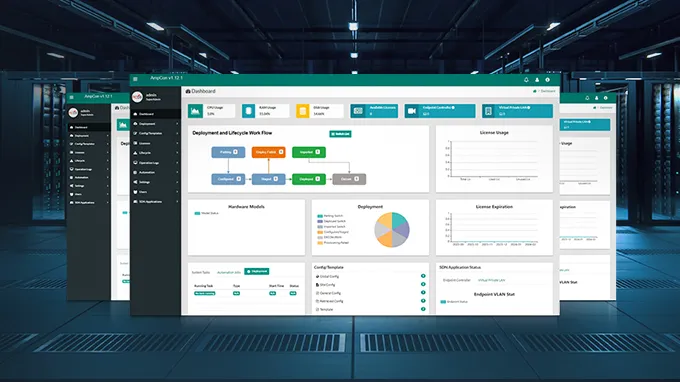What Are the Common 400G QSFP-DD Transceiver Types in the Market?
The continuous growth in global data traffic has promoted data centers to upgrade from 100G to 400G networks. 400G optical modules, as the most common high-efficient and cost-effective solution to 400G network, can greatly improve system performance, fasten transmission speed, broaden bandwidth, and reduce broadband costs. Therefore, this article will mainly introduce 400G QSFP-DD optical modules from the aspects of form factors, application scenarios, FAQs, and future trends.
Common 400G QSFP-DD Transceiver Types
Generally, there are eight common 400G QSFP-DD transceiver types in the market. Here will describe the basic information of QSFP-DD SR8, QSFP-DD DR4, QSFP-DD XDR4, QSFP-DD FR4, QSFP-DD FR8, QSFP-DD LR4, QSFP-DD LR8, and QSFP-DD ER8.
400G QSFP-DD SR8
The 400G QSFP-DD SR8 is a four-channel, hot-pluggable optical module that supports MMF links up to 70m (OM3) or 100m (OM4) with an MPO-16 connector, making it ideal for short-distance interconnection. It complies with QSFP-DD MSA specification and IEEE 802.3bs protocol and includes eight parallel transceiver lanes, each of which is capable of a transmission rate of 53.125 Gbps (PAM 4), to transmit data rates of 400 Gbps.
400G QSFP-DD DR4
The 400G QSFP-DD DR4 achieves a max transmission distance of 500 meters on 1310nm center wavelength over SMF with an MPO-12 connector. DR4 stands for "Dense Wavelength Division Multiplexing (DWDM) 4-lane", which means that the 400G DR4 module uses four optical lanes to transmit data, each of which is capable of carrying data at a rate of 106.25Gbps (PAM4), reaching a 425G transmission rate.
400G QSFP-DD XDR4
The 400G QSFP-DD XDR4 is an extended version of the 400G QSFP-DD DR4 optical module, of which transmission distance is longer than QSFP-DD DR4, supporting a maximum link up to 10km over SMF with MTP/MPO-12 connector, complying with IEEE 802.3bs protocol and QSFP-DD MSA standard. And it has four parallel transceiver lanes, which allows a total transmission rate of 400G.
400G QSFP-DD FR4
The 400G QSFP-DD FR4 (stands for "Full Duplex 4-lane, Retimed 4-level" ) is a 400Gbps hot-pluggable transceiver and supports SMF links up to 2km reach over duplex LC connectors. The 400G FR4 transceiver incorporates 4 independent lanes on CWDM4 center wavelengths running at 100Gbps per lane, follows a protocol of 100G Single Lambda MSA specification, and can be used in data centers to provide high-speed data transmission. The single-wavelength transmission rate based on PAM4 modulation can reach 106.25Gbps, achieving a total transmission rate of 400G.
400G QSFP-DD FR8
The 400G QSFP-DD FR8 module adopts the same 50G PAM4 modulation technology as the 400G QSFP-DD SR8. It uses eight optical lanes to transmit data and can reach a maximum transmission rate of 400Gbps. However, unlike SR8, which only fits short-distance transmission, 400G FR8 can be applied in long-distance transmission, with a maximum transmission range of 2km.
400G QSFP-DD LR4
The 400G QSFP-DD LR4 is a high-speed, high-bandwidth, and long-distance transmission transceiver, appropriate for application scenarios like 400G ethernet and data center interoperability. It supports SMF links to 10km over duplex LC connectors and complies with IEEE 802.3bs protocol and QSFP-DD MSA standard.
400G QSFP-DD LR8
The 400G QSFP-DD LR8 also adopts 50G PAM4 modulation technology as SR8 and FR8 and has eight parallel transceiver lanes. However, in contrast to SR8 and FR8, each lane allows longer transmission distances of up to 10km over SMF with duplex LC connectors and has a maximum transmission rate of 106.25Gbps, for a total of 425G.
400G QSFP-DD ER8
The 400G QSFP-DD ER8 has the same transmission rate, modulation technology, and connector as QSFP-DD LR8. It complies with IEEE 802.3cn protocol and QSFP-DD MSA standard. The only difference exists in the transmission distance. The ER8 can achieve a maximum transmission distance of 40km, making it more adapted to ultra-long-distance data transmission.
400G QSFP-DD Optical Modules Application Scenarios
As a low-cost, low-power optical connection solution in the next-generation data centers, 400G QSFP-DD series optical modules are widely used in data centers, metropolitan bearer network, and long-distance high-capacity transmission.
400G QSFP-DD Data Center Direct Interconnection
In the data center architecture, the connection between servers, switches, and servers and switches all need to use optical modules, optical fiber jumpers or other transmission carriers to achieve data interoperability. The following picture shows the direct connection of 400G QSFP-DD transceivers in the data center.

Metropolitan Bearer Network
Cloud computing, big data, ultra-high-definition video, Internet of Things, VR/AR, 5G and Internet of Vehicles have created new requirements for bearer networks: ultra-high bandwidth, massive connections, ultra-low latency, and high reliability. During the large-scale 5G commercialization of the metropolitan area network, the core layer bandwidth will be developed to 200GE/400GE since traditional 100GE ports fail to accommodate the requirements of 5G aggregation and core layer for ultra-broadband. Therefore, the optical interconnection solution based on 400G becomes an inevitable choice.

Long-Distance High-Capacity Transmission
Long-distance transmission is in high demand for the market as new services continue to emerge in an endless stream, raising the requirements for the transmission network bandwidth. Also, intercom operators put up higher standards for network management and modulation flexibility. All of these aspects support the 400G application in long-distance transmission because it can use a single 400G wavelength to operate 400G ports, modify the wavelength path in accordance with organizational needs, achieve direct wavelength access in the optical path, and reduce latency and power consumption.

FAQs about 400G QSFP-DD Transceivers
400G QSFP-DD Transceiver Future and Trends
The technical advancement of 400G improves the efficiency and capacity of data transmission and brings a better network experience for users. With the merits of high bandwidth, low latency, and low power consumption, the 400G QSFP-DD module might be the ideal choice for next-generation wireless networks and ultra-large-scale data centers.
You might be interested in
Email Address

-
PoE vs PoE+ vs PoE++ Switch: How to Choose?
May 30, 2024













